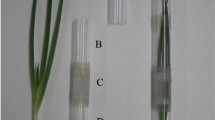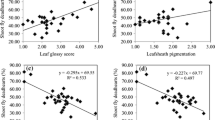Abstract
Sorghum shootfly, Atherigona soccata, oviposition and infestation on eight resistant sorghum cultivars (IS nos: 2122, 2123, 2205, 2291, 4660, 5092, 5480 and 18551) and two susceptible cultivars (Serena and CSH-1), were studied under field conditions (natural infestation). The eight resistant cultivars and CSH-1 were also tested for preference for oviposition in a two-choice situation in the screenhouse. The eight resistant cultivars received considerably less shootfly eggs and showed fewer “dead hearts” than the susceptible cultivars. The results indicate that non-preference for oviposition is an important mechanism for resistance to shootfly in eight test cultivars. There was also evidence for a certain degree of antibiosis in IS 2291.
Résumé
La mouche de sorgho, Atherigona soccata, oviposition et infestation sur huit cultivars de sorgho (IS nos: 2122, 2123, 2205, 2291, 4660, 5092, 5480 et 18551) ont montré une résistance a la mouche de sorgho et deux cultivars susceptibles (Serena et CSH 1) ont été étudiés dans les champs (infestation naturelle). Les huit cultivars résistants et CSH 1 ont été testés quant a la préférence de la mouche pour oviposition dans une situation à deux choix dans la maison de dépistage. Les huit cultivars résistant ont reçu considérablement moins d’oeufs et ont montré de coeurs morts (dead hearts) que des cultivars susceptibles. Les résultats ont montré que la non-préférence pour oviposition est un mécanisme important pour la résistance dans les huit cultivars experimentaux. On a décelé aussi un certain degré d’antibiose dans IS 2291.
Similar content being viewed by others
References
Blum A. (1967) Varietal resistance of sorghum shootfly (Atherigona varia soccata). Crop Sci. 7, 461–462.
Blum A. (1969) Oviposition preference by the sorghum shootfly (Atherigona varia soccata) in progenies of susceptible x resistant sorghum crosses. Crop Sci. 9, 695–696.
Delobel A. G. L. (1983) Influence of temperature and host plant condition on preimaginal development and survival in the sorghum shootfly Atherigona soccata. Insect Sci. Applic. 4, 327–335.
Doggett H. (1972) Breeding for resistance to sorghum shootfly in Uganda. In Control of Sorghum Shootfly (Edited by Jotwani M. G. and Young W. R.), pp. 192–201. Oxford and IBH, New Delhi.
Jain K. K. and Bhatnagar M. P. (1962) Studies on varietal resistance to Jowar shootfly. Indian J. Genet PI. Breed. 22, 224–229.
Jotwani M. G. (1976) Host plant resistance with special reference to sorghum. Proc. Indian natn. Acad. Sci. 463, 42–48.
Jotwani M. G., Sharma G. C., Srivastava B. G. and Marwaha K. K. (1971) Ovipositional response of shootfly Atherigona varia soccata Rondani on some promising resistant sorghum. In Investigations on Insect Pests of Sorghum and Millets. Final Technical Report 1965–70, pp. 119–122. Division of Entomology, IARI, New Delhi, India.
Maiti R. K., Bidinger F. R., Seshu Reddy K. V., Gibson P. and Davies J. C. (1980) Nature and occurrence of tri-chomes in sorghum lines with resistance to sorghum shootfly. In Joint Progress Report, Sorghum Physiology — 3/Sorghum Entomology—3, p. 40. ICRISAT, Andhra Pradesh, India.
Raina A. K. (1981) Deterrence of repeated oviposition in sorghum shootfly Atherigona soccata. J. chem. Ecol. 7, 785–790.
Raina A. K., Thindwa H. Z., Othieno S. M. and Corkhill R. T. (1981) Resistance in sorghum to the sorghum shootfly: larval development and adult longevity and fecundity on selected cultivars. Insect Sci. Applic. 2, 99–103.
Shie Shiang-Lin, Fan Zi-De and Su Shou-Hua (1981) Studies on the sorghum shootfly in China. Insect Sci. Applic. 2, 39–47.
Singh S. P. and Jotwani M. G. (1980) Mechanisms of resistance in sorghum to shootfly 1. Ovipositionai nonpreference. Indian J. Ent. 42, 353–360.
Singh S. R., Vedamoorthy G., Thobbi V. V., Jotwani M. G., Young W. R., Balan J. S., Srivastava K. P., Sandhu G. S. and Krishnanda N. (1968) Resistance to stem-borer, Chilo zonellus (Swinhoe) and stem fly Atherigona varia soccata Rond, in the World sorghum collection in India. Mem. ent. Soc. India 7, 1–79.
Singh S. P., Jotwani M. G., Rana B. S. and Rao N. G. P. (1978) Stability of host-plant resistance to sorghum shootfly Atherigona soccata. Indian J. Ent. 40, 376–383.
Young W. R. (1972) Sources of resistance to the sorghum shootfly Atherigona varia soccata Rond. In Control Sorghum Shootfly (Edited by Jotwani M. G. and Young W. R.), pp. 137–148. Oxford and IBH, New Delhi.
Young W. R. and Teetes G. L. (1977) Sorghum entomology. A. Rev. Ent. 22, 193–218.
Author information
Authors and Affiliations
Rights and permissions
About this article
Cite this article
Unnithan, G.C., Seshu Reddy, K.V. Oviposition and Infestation of the Sorghum Shootfly, Atherigona soccata Rondani, on Certain Sorghum Cultivars in Relation to their Relative Resistance and Susceptibility. Int J Trop Insect Sci 6, 409–412 (1985). https://doi.org/10.1017/S1742758400004719
Received:
Published:
Issue Date:
DOI: https://doi.org/10.1017/S1742758400004719




